Un sitio web rápido es esencial para que los visitantes estén contentos y los motores de búsqueda ocupen los primeros puestos. Los motores de búsqueda como Google consideran que la velocidad del sitio es un factor de clasificación importante.
WP Super Cache es un popular plugin que crea archivos HTML estáticos de tus páginas web. Esto significa que tu servidor no tiene que trabajar tanto, haciendo que tu sitio cargue más rápido para los visitantes.
Utilizamos plugins de rendimiento como Cloudflare y WP Rocket para mejorar la velocidad de WPBeginner. WP Super Cache es una alternativa gratuita que puede mejorar significativamente el rendimiento, impulsar el SEO y mejorar la experiencia de usuario para los visitantes del sitio web.
En este artículo, te guiaremos para que instales y configures WP Super Cache en tu sitio de WordPress. Explicaremos cada paso de forma vacilar, así que incluso si no eres un experto en tecnología, podrás seguir el proceso. Al final, tendrás un sitio web más rápido que los visitantes y los motores de búsqueda apreciarán.
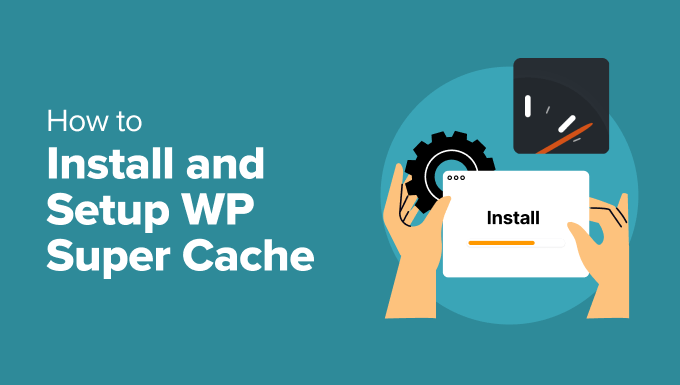
¿Qué es WP Super Cache y por qué deberías usarlo?
WP Super Cache es uno de los mejores y más populares plugins de caché para WordPress. Es una herramienta gratuita y tiene más de un millón de instalaciones activas.
WP Super Cache hace una copia en caché de cada página de su sitio en forma de archivo HTML estático. De esta manera, cada vez que alguien visita su sitio, se le sirve la versión copiada rápidamente en lugar de generar todo el sitio web desde cero.
Como resultado, la velocidad y el rendimiento de su sitio WordPress mejoran drásticamente. El plugin de caché omite muchos pasos entre bastidores para que tus visitantes no tengan que esperar a que se abra la página.
Esto mejorará la experiencia de los visitantes de su sitio web. Un sitio que se carga rápidamente anima a la gente a visitarlo más a menudo, lo que lleva a una mayor participación y conversiones, ya que los usuarios pasan más tiempo en sus entradas y páginas.
Además de eso, con un sitio web de carga rápida, también puede ver un impulso en su WordPress SEO y posicionamiento en buscadores. Esto se debe a que Google da una ventaja significativa a los sitios web más rápidos, ya que utiliza la velocidad del sitio web como un factor de clasificación.
¿Estás listo para establecer WP Super Cache en tu sitio web? ¡Manos a la obra!
Establecer WP Super Cache – la manera fácil
Lo primero que tienes que hacer es instalar y activar el plugin WP Super Cache en tu sitio web. Para más detalles, puedes seguir nuestra guía sobre cómo instalar un plugin de WordPress.
Una vez activado, WP Super Cache le avisará de que el almacenamiento en caché no está activado / activo en su sitio web en este momento.
Para activar la caché, vaya a Ajustes ” WP Super Cache. Luego, en la pestaña ‘Fácil’, ve y haz clic en la opción ‘Caché Activada’. Una vez hecho esto, haz clic en el botón ‘Actualizar estado’.

Después de activar la caché, tendrás que desplazarte hasta la sección “Comprobador de caché”.
Una vez allí, debes hacer clic en el botón “Probar caché” para comprobar si funciona.
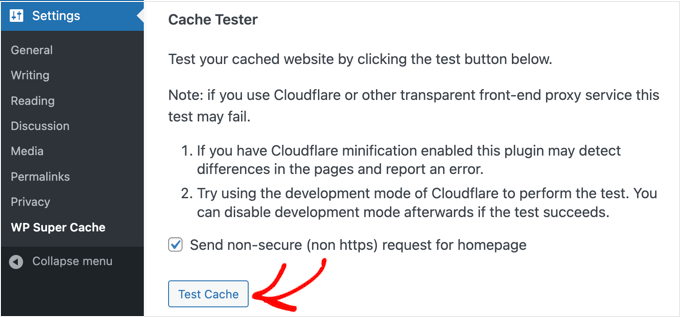
WP Super Cache buscará su sitio WordPress dos veces y comparará las marcas de tiempo de ambas páginas. Si ambas marcas de tiempo coinciden, significa que el almacenamiento en caché está funcionando en su sitio ahora.
Configuración avanzada de WP Super Cache
WP Super Cache es un potente plugin para WordPress que viene con un montón de opciones avanzadas. Estas opciones pueden mejorar aún más el rendimiento de su sitio y darle más control sobre cómo el plugin almacenará en caché su sitio.
Activar caché
Para establecer WP Super Cache con opciones avanzadas, ve a la pestaña ‘Avanzado’ en los ajustes del plugin WP Super Cache. A continuación, haz clic en la casilla de verificación “Activar caché”.
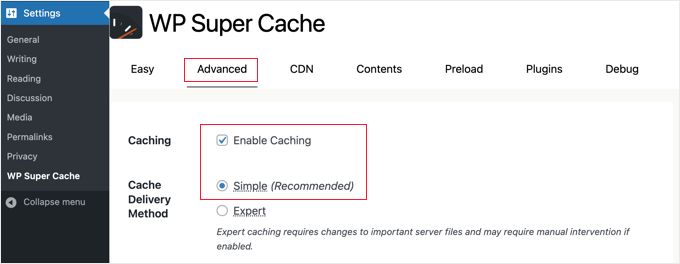
Debajo de la caché, verás opciones para el ‘Método de entrega de caché’. Le recomendamos que utilice la opción ‘Simple’ si es principiante y no está familiarizado con la edición de los archivos de su servidor.
Una vez elegida la opción de almacenamiento en caché, asegúrese de hacer clic en el botón “Actualizar estado”.
Activar la compresión en WP Super Cache
La compresión permite a WP Super Cache servir archivos en caché como archivos comprimidos, lo que mejora el tiempo de carga. Estos archivos son más pequeños y pueden ser descargados por los navegadores más rápidamente.
Para activar la compresión, desplácese hasta la sección “Varios” de la pestaña de ajustes “Avanzados” y marque la casilla “Comprimir páginas para que se sirvan más rápidamente a los visitantes”.

Una vez más, haga clic en el botón “Actualizar estado” para guardar los cambios.
Activar el caché dinámico
Si desea mantener ciertas partes de una página web dinámica durante el almacenamiento en caché, entonces WP Super Cache ofrece una opción para ello.
Activar la caché dinámica es útil en determinadas situaciones, especialmente si tiene páginas cuyo contenido cambia con frecuencia. Por ejemplo, puedes acelerar las páginas que contienen anuncios si activas la caché dinámica.
Para activar esta opción, vaya a la sección “Avanzado” y haga clic en la casilla de verificación “Activar caché dinámica”.

Asegúrate de guardar los cambios cuando hayas terminado.
Establecer la caducidad y la recogida de basuras
WP Super Cache también le permite establecer el tiempo de caducidad y la frecuencia para borrar las páginas almacenadas en caché de su servidor.
Para empezar, sólo tiene que desplazarse hasta la sección “Tiempo de caducidad y recogida de basura” de la pestaña “Avanzado” para configurarlo.

El ‘Tiempo de espera de la caché’ indica al plugin que elimine la página en caché y realice una nueva caché. El plugin lo establecerá en 1800 segundos por defecto, lo que es ideal para un sitio web con mucho tráfico.
Sin embargo, si tiene un sitio web nuevo que no recibe mucho tráfico, 3600 segundos es un buen punto de partida.
Aparte de eso, puede programar una hora para que el plugin compruebe si hay archivos antiguos en caché y los elimine.
Cuando haya terminado de hacer sus selecciones, tendrá que hacer clic en el botón “Cambiar caducidad” para guardar los cambios.
Especifique las páginas que no desea que se almacenen en caché
Por defecto, el plugin almacenará en caché todas las páginas de su sitio. Esto puede aumentar el tamaño de sus archivos de caché y utilizar más recursos. Sin embargo, WP Super Cache le permite elegir las páginas que no desea que se almacenen en caché.
Puede desplazarse hasta la sección “Cadenas de URL rechazadas” en la pestaña “Avanzado” para utilizar esta característica. En el cuadro de texto, introduzca la cadena URL de las páginas que no desea que el plugin almacene en caché.
Por ejemplo, si tiene una tienda de comercio electrónico, puede excluir páginas que los visitantes no visitan a menudo y guardar o ahorrar recursos del servidor. Estas pueden ser la página de finalizar compra / pago, la página de cuenta y la página de agradecimiento.
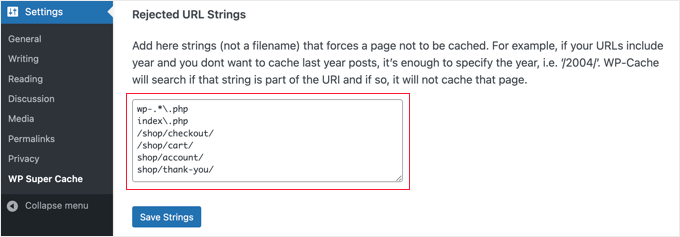
Cuando hayas terminado, no olvides hacer clic en el botón “Guardar cadenas”.
Establecer WP Super Cache para que funcione con su CDN
Si también está utilizando un servicio de Red de Entrega de Contenidos (CDN) para acelerar su sitio web, entonces puede configurar WP Super Cache para trabajar con él. De lo contrario, puede omitir esta sección.
Una CDN es una red de servidores distribuidos en diferentes ubicaciones geográficas, que ayuda a entregar rápidamente el contenido a sus visitantes. Para más detalles, echa un vistazo a nuestra infografía sobre por qué necesitas una CDN.
Consejo: Recomendamos utilizar Cloudflare porque es un proveedor de CDN gratuito fácil de establecer. Consulta nuestro tutorial sobre cómo establecer la CDN gratuita de Cloudflare en tu sitio de WordPress.
Para establecer que WP Super Cache funcione con tu CDN, sigue adelante y haz clic en la pestaña CDN en tus ajustes. A continuación, marca la casilla situada junto a la opción “Activar soporte para CDN”.
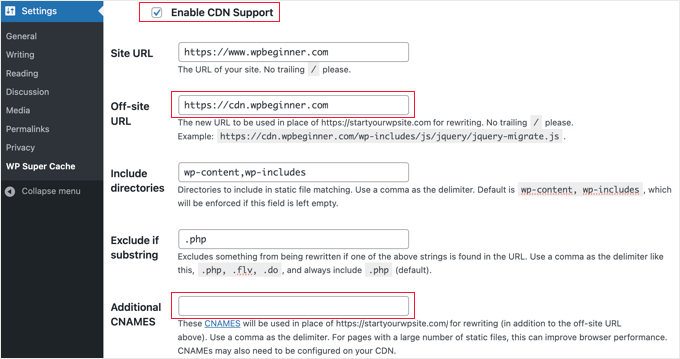
A continuación, debe introducir su “URL externa”. Se trata de la “zona de extracción” de su CDN, es decir, la URL en la que se almacenan sus archivos en la CDN.
El ajuste aquí depende de su servicio CDN, pero aquí tiene algunos consejos:
- Si está usando Cloudflare, entonces debe dejar este campo en blanco. WP Super Cache detectará y funcionará automáticamente con Cloudflare.
- Si utiliza un servicio de CDN diferente, introduzca algo como: https:
//cdn.wpbeginner.com.Asegúrese de sustituir “wpbeginner.com” por el nombre de dominio de su sitio web. - En caso de duda, puede acceder a su servicio CDN y comprobar los ajustes de “dominio”, “dominio CDN” o “URL CDN” en el tablero de su cuenta.
Si sabe que su CDN tiene varias URL, puede introducirlas en el campo “CNAMES adicionales”, por ejemplo: http: //cdn1.wpbeginner.com, http://cdn2.wpbeginner.com, http://cdn3.wpbeginner.com. De lo contrario, debe dejar este campo en blanco.
Puede dejar los demás ajustes por defecto. Por último, marque la casilla “Omitir URL https para evitar errores de “contenido mixto”” y, a continuación, haga clic en el botón “Guardar cambios”.

Ahora, su sitio web está listo para servir contenido estático desde una CDN.
Servir un sitio estático con WP Super Cache
El modo de precarga en WP Super Cache te permite crear archivos estáticos super cache para todas tus entradas y páginas y servir un sitio web estático. De esta manera, su contenido se cargará rápidamente cada vez que alguien visite su sitio.
Un archivo estático supercache ayuda a conservar los recursos del servidor, servir un sitio antiguo que ya no se actualiza y mejorar la velocidad del sitio sirviendo solo contenido estático.
Para empezar, dirígete a la pestaña “Precarga” del plugin WP Super Cache. A continuación, puede establecer el tiempo de actualización de los archivos de caché precargados.
Por defecto, el plugin lo establecerá en 600 minutos, pero puedes reducir el tiempo si publicas varios artículos cada día.
Recuerde que precargar todo su sitio WordPress lleva algún tiempo y consume muchos recursos de su servidor. Puedes dejarlo a 0 si no quieres que tus archivos estáticos caduquen nunca, a menos que refresques manualmente la caché.
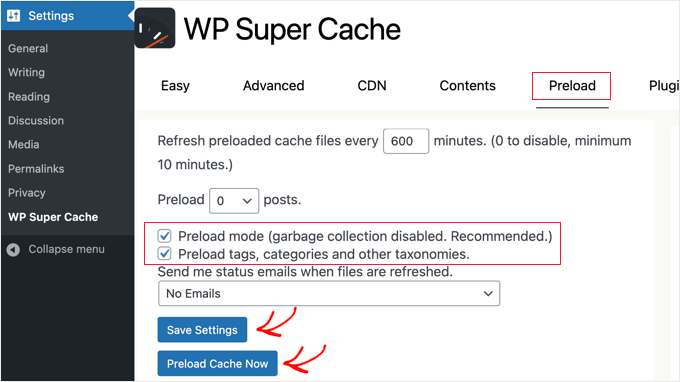
Después, asegúrese de marcar / comprobar las casillas de ‘Modo de precarga (recolección de basura desactivada. Recomendado)’. También puede activar la precarga para diferentes etiquetas, categorías y otras taxonomías de su sitio web.
El plugin también ofrece la opción de recibir alertas por correo electrónico cada vez que se actualicen tus archivos. Por defecto, utilizará el ajuste “Sin correo electrónico”, pero puedes cambiarlo eligiendo una opción del menú desplegable.
Cuando hayas terminado, guarda los ajustes y haz clic en el botón “Precargar caché ahora”.
Guías de expertos sobre el almacenamiento en caché de WordPress
Esperamos que esta guía te haya ayudado a establecer WP Super Cache en tu blog WordPress. Quizás te interese ver otros artículos relacionados con la caché de WordPress:
- Cómo corregir fácilmente la advertencia de almacenamiento en caché del navegador en WordPress
- Cómo vaciar la caché de WordPress (paso a paso)
- Los mejores plugins de caché de WordPress para acelerar su sitio web
- LiteSpeed Cache vs. WP Rocket – ¿Cuál es mejor?
- Cómo instalar y configurar correctamente WP Rocket en WordPress
- Cómo instalar y configurar W3 Total Cache para principiantes
- La guía definitiva para aumentar la velocidad y el rendimiento de WordPress
- Cómo acelerar el rendimiento de WooCommerce
If you liked this article, then please subscribe to our YouTube Channel for WordPress video tutorials. You can also find us on Twitter and Facebook.




Anze
Hey; I have a question – so preload mode enabled does not deletes old cached files – but does that means then when preloaded files are refreshed, the old ones are deleted and replaced, or does it just adding files, which would mean space on server would eventually run out?
WPBeginner Support
When the page is preloaded a new time, the old preloaded version would be deleted and replaced.
Admin
James Omeke
Thanks so much . This was very helpful.
I got my website up and running now
WPBeginner Support
You’re welcome, glad our guide was helpful!
Admin
Mike Royden
Plug in installed, but can’t get past this;
Permalink Structure Error
A custom url or permalink structure is required for this plugin to work correctly. Please go to the Permalinks Options Page to configure your permalinks.
I have gone to the Permalinks Options Page to configure your permalinks, but can’t see where I’m going wrong. Going round in circles, please help. Thanks
WPBeginner Support
You would want to ensure your permalinks are not set to plain for that error. We recommend using the Post name structure.
Admin
Mike Royden
Sorted! Many thanks for your advice and taking the time to reply. Cheers.
Katherine
I’m trying to set up this plug in to get the best results, and I’m not tech-savvy at all. Your Wp advanced cache set up section is not the same as the current plugin advanced options.
WPBeginner Support
Thank you for letting us know, we will be sure to take a look into this and update our article when able.
Admin
Simon
I was able to speed up my homepage significantly but unfortunately it only worked for the homepage. The subpages like i.e. ‘Services’ are still really slow.
What could be the problem?
WPBeginner Support
You would want to run a speed test for that using our guide below to figure that out:
https://www.wpbeginner.com/beginners-guide/how-to-properly-run-a-website-speed-test-best-tools/
Admin
Rainey
Unable to activate the plugin. I get a warning message that a .php file already exists and I should manually delete it before using the plugin. Since I am not a techie I do not know where to go to delete the file. If you could put language in your update to the tutorial to guide us would be really helpful.
WPBeginner Support
For that error, you may want to follow our guide below:
https://www.wpbeginner.com/wp-tutorials/how-to-fix-destination-folder-already-exists-error-in-wordpress/
Admin
Paul
This post is dated. When will this post be updated? Would like to know the current status of WP Super Cache?
WPBeginner Support
Thank you for letting us know, we do not have a specific date that content will be updated but we will take a look into updating this article
Admin
Nic
Is there a way to export settings once you get done?
WPBeginner Support
At the moment WP Super Cache does not have a built-in option to export settings.
Admin
ShoaiB
Thank you for this Awesome Guide.
I’m using WP Super Cache (Version 1.7.0 ). In the above tutorial, many features are not included. plz, Update Post.
WPBeginner Support
Thank you for your request, we will look into updating the post
Admin
Christopher
not as easy as described…
A custom url or permalink structure is required for this plugin to work correctly. Please go to the Permalinks Options Page to configure your permalinks.
WPBeginner Support
Thank you for reminding us of that, we’ll be sure to look into updating the article for clarification.
Admin
Ana
Hello Support!
Thank you for all your work, I’m a complete newbie and without you, I don’t know how I’d manage.
I’m confused as regards what off-site URLs and CNames are, so I’m unable to fill in that in the form. Do I have to refer to somewhere on my page to find out or do I just create it my indicating something?
Just in case it affects somehow I’d like to inform that I run a multisite.
Thank you so much & hope you can help me,
Ana
WPBeginner Support
Hi Ana,
The off site URL is the URL of your CDN location and CNames are different pullzones you have created on your CDN server. If you are not using a CDN, then you don’t need to make any changes to these settings.
Admin
krishna
can i use this plugin for testing in localhost ??
i installed this plugin in localhost and in “Cache Contents” nothing cached
displaying this …
WP-Cache (0KB)
0 Cached Pages
0 Expired Pages
WP-Super-Cache (0KB)
0 Cached Pages
0 Expired Pages
is it because i can’t use cache plugin in localhost or some other issue ?
Hardik
There is nothing called MOD_REWRITE. Everything from that step seems completely different. Please update the tutorial.
Mike
No matter what settings I use Pingdom still gives me an F and says “The following cacheable resources have a short freshness lifetime. Specify an expiration at least one week in the future for the following resources:” and I see and “expiration not specified” message in the details. Am I missing a setting?
Akshay
Hi Team ,
Thanks for the amazing article .
I have installed WP Super Cache with cloudflare (newbie blogger).
Can you please help me, how can I integrate cloudflare with WP super cache .
I did not found any articles or vidoes for the same .
I thought of installing WP Total , but it has not releasedthe update for recent wordpress version 4.8.1
Thank You
Sumaiya
Hi, I wanted to speed up my site. I used this guide and customized the settings as you shown. But before installing this plugin I tested my site speed it was 4.20 sec. But after installing I check it was 6.78 sec. Why is it like this? please guide me well.
WPBeginner Support
Hi Sumaiya,
Please test it again. If the result persists, then deactivate the plugin.
Admin
Rajeev jaiswal
hello sir, I’m trying to integrate js and CSS code elements in twenty-seventeen WordPress theme. I use enqueue methods but it does not work, so suggest me to all about.
Sara
I just downloaded WP Super Cache and the “Advanced” Page doesn’t have the same setup (or some of the same options!) as your screenshot and instructions. Are those dates, or did I somehow end up with an older version of the plugin?
Carrie
Same here, my settings are different.
Abner
Hi guys – Thanks for sharing this. I am using wp super cache and my wordpress is 4.0.1. At first, i don’t have any problem. Until recently, having a problem. My post did not appear on my website. I tried to put the caching off and my post appear. After that, I put the caching on again. My workaround was after posting article to my website, I will put my caching off to appear the post in my website, then after a few minutes, I will put the caching to on.
Few weeks doing that, and now, when I put the caching on, my post will disappear again to my website. As of now, my caching is still off.
Thanks and hope you can help me.
WPBeginner Support
Hi Abner,
Seems like WP Super Cache is not clearing the cache when you publish new content. Please see our article on how to clear cache in WordPress.
Admin
Mark Layton
Hello Support,
Thank You for your help with this issue while trying to install WP Super Cache.
Here is a copy of issue :
Warning! Could not update /var/www/website/wp-config.php! WPCACHEHOME must be set in config file.
Warning! /var/www/website/wp-content/advanced-cache.php does not exist or cannot be updated.
1. If it already exists, please delete the file first.
2. Make /var/www/website/wp-content writable using the chmod command through your ftp or server software. (chmod 777 /var/www/website/wp-content) and refresh this page. This is only a temporary measure and you’ll have to make it read only afterwards again. (Change 777 to 755 in the previous command)
3. Refresh this page to update /var/www/website/wp-content/advanced-cache.php
If that doesn’t work, make sure the file /var/www/website/wp-content/advanced-cache.php doesn’t exist:
1. Open /var/www/website/wp-content/plugins/wp-super-cache/advanced-cache.php$wp_cache_file in a text editor.
2. Change the text CACHEHOME to /var/www/website/wp-content/plugins/wp-super-cache/
3. Save the file and copy it to /var/www/website/wp-content/advanced-cache.php and refresh this page.
Cannot continue… fix previous problems and retry.
Already use your Envira Gallery and WP Forms and those are fantastic.
Should I just use W3 Total Cache instead?
Thank You so much for your help.
Mark Layton
WPBeginner Support
Hey Mark,
You can try following the instructions shown in WP Super Cache. If you find them too complicated, then you can try W3 Total Cache. Good luck
Admin
sheikave Jhurreea
Initially my website was loading for under 8 seconds which is pretty bad. But using your tutorial I was able get 90/100 for desktop performance.
But the mobile platform it remained 74/100. Could you suggest some resources where I could look up too or what is your suggestion.
WPBeginner Support
Hey Sheikave,
Congrats! That’s impressive. You may also want to see our guide on how to fix render-blocking JavaScript and CSS in WordPress.
Admin
Greg
Hi, I’d like to know whether your guidance to choose mod_rewrite to serve cache files still stands as opposed to using PHP or Legacy Caching. I notice since you published your article, WP Super Cache have changed their own recommendation from mod_rewrite to PHP.
Thanks in advance!
Greg
Dillon
Hi there. I’ve followed this tutorial to a T, and for the most part, everything works correctly, but I’m having two problems. First, when I make changes, they don’t appear on the site if I’m logged in. If I log out, they appear just fine. Second, I’m working on a WPMU network, and I only have the plugin installed on one site. But it’s caching the other sites on the network as well. How do I stop it from doing that? Thanks!
Belayet Hossain
This is an awesome guideline for new users.
It helped me a lot.
Thanks from the core of heart.
Sarah
Hi,
I followed your steps because my site was taking over 5s to load but after setting up the WP Super Cache my site wouldn’t load. At all. It was basic HTML – no content, no pictures, just the header…
So, I guess I’m wondering if there’s a laymen’s guide to literally all the terms you use cause I don’t understand websites or programming and I have a website for a start-up NGO so can’t really pay for any help at this point.
Or maybe you could direct me somewhere that will help me understand all this better? I’m a complete novice and confused easily!
Help!
Pedro Moreira
Hello,
I have a “conceptual doubt” about WP Super Cache, that I didn´t see answered neither in your site neither in other sites.
The question is: the structure of my site is finished. In basic terms, it is mainly a site of videos of football, which means that from this day on I will gradually add posts (that include the videos that I refered) and pages (of the teams).
Since that this will be a long and permanent process, I need right now to speed up my site because nowadays is very slow.
My doubt is: when I install and configue this plugin, what does that mean in terms of the updates that I will do in my site (post and pages that I add)?
I mean, if I cache the site today and tomorrow I add a new page or post, what do I have to do in order that these pages or posts will be also cached? – do I just have to require an update of the plugin? If so, how do I do that, is it possible to define that the plugin will update the cache for example once a week?
Thank you!
Best regards.
Bogdan
If i don„t use set up the CDN ,the wp super cache will be work properly ?
WPBeginner Support
Yes, it will work even without CDN.
Admin
Herman
I’m getting an error on the first step where you need to click on caching on and update. You mentioned the following in your article:
“WP Super Cache will fetch your WordPress site twice and will compare the time stamps of both pages. If the both time stamps match then this means that caching is working on your site now.”
This is the place where I get the error. I get a message that says:
Fetching to prime cache: OK
Fetching first copy of FAILED
Fetching second copy of : FAILED
I would be glad if you could help me out.
Sofor
Thank you so much, It works great for me.
Teddy
My site is a coupon site, so code is included on the coupon so it prints out by itself without lots of other junk that is on the page. If I use WP Super Cache, will that code be lost because it’s now a static page? Will people still be able to click on the coupon to print just the coupon?
WPBeginner Support
Hi Teddy,
You will have to test it out first on your computer or in a staging environment.
Admin
Alex
Thanks so much for the the help. Do i have to create a cname record to use the CDN service in WP super cache. Thanks
Stefan Andonov
Hi,
How to preload for several languages, I am using qtranslate, that seems impossible, right?
10x
Stefan
John Johnson
This is an ecommerce site using Exchange from iThemes. With WP Super Cache activated certain pages that need to be refreshed don’t get refreshed i.e. Empty Cart. When you Empty Cart it comes back with the same content or in other words it appears unemptied.
When I deactivate WP Super Cache the problem disappears. It was suggested that I Whitelist the pages that shouldn’t be cached. I am uncertain about how to do that. Any help would be appreciated.
Regards,
John
Dajuan
WP Beginner Staff, when a theme update is applied, or when other plugin updates are made, is WP Super Cache alerted to create new cached versions? Or does the plugin wait until “Expiry Time & Garbage Collection” or a manual cache deletion?
Iosif
Hello,
I am using WP Super Cache, but it seems that my images don’t get cached. Any ideas on how to configure this?
I did have a lazy load plug-in, but it conflicted with my theme, so I deactivated it…
shubhendu
I have just install wp super cache plugin by reading your article but nor js,css and image is not loading at my blog…plz help my site address is
If you dont want to publish is comment because i include my site link PLEASE reply to my email id.
Thanks.
WPBeginner Support
Seems like you have already resolved the issue.
Admin
madhavi jha
hi , i am regular reader of your site , i have setup WP Super Cache plugin as you guide in your blog , but its not working its show only 20/100
please guide me ,i have been tried to solve this problem since last 2 days , please guide me .
nitai roy
Hi,
I followed as you mentioned here. Everything has done perfectly but I could not find this option: “Enable Compression in WP Super Cache:”
Where is it please?
Also, Now how can I know whether it is working perfectly or not?
Thank you very much.
Patel Shoeb
How to Install and Setup WP Super Cache with CloudFlare CDN?
kurakaniz
after updating the plugin it says “.htaccess file may need to be moved” and this error too
A difference between the rules in your .htaccess file and the plugin rewrite rules has been found. This could be simple whitespace differences but you should compare the rules in the file with those below as soon as possible. Click the ’Update Mod_Rewrite Rules’ button to update the rules.
what to do please help
Ron
Same problem here.Anyone help
stephen
I installed everything just as you said but I am still getting 52sec load time and if I tried using gtmetrix I get an error saying the URL does not appear to be an HTML.home page . please help site is
Megan Good
This article was very helpful, and I was able to troubleshoot my issues based on your suggested settings. Thank you for the info!
Omprakash Jaiswal
wp super cache does not work
Permlink Structure Error
A custom url or permalink structure is required for this plugin to work correctly. Please go to the Permalinks Options Page to configure your permalinks.
Hammad
Thank you for your suggestions, I’m trying to apply these settings on my website now. Can you please advise if wp super cache supports minify settings.
I had wp3 total cache and had a score of 97/81 on gtmetrix, after installing wp super cache my score decreased to 82/68.
Imran
Was looking for some great guide for super cache plugin. Now I will try it on my test site.
Thanks for such a nice tutorial
Robert Connor
Some great tips-now i need to go back and fix my site
User
How do I get it to work for Mobile without changing the theme?
cezars
Any info for Rejected User Agents list from the plugin ?
herb
Installed it and got a lower grade E/D on Gtmetrix…switched to W3TC and it gave me and A/B grade.
efiga
Hi
i have a little question , when using this plugin to cashe pages , the google adsense ads will be cashed too ? ,it will show the same ads ?
thank you in advance
WPBeginner Staff
No your Google Ads will not be cached.